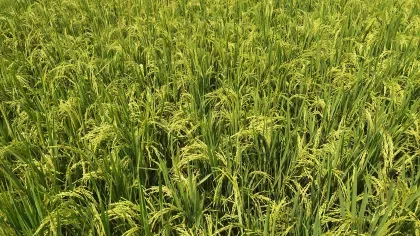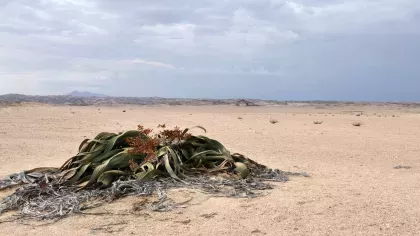
Ginkgo tree
On this page
The ginkgo tree is one of the oldest living tree species in the world.
Known as a ‘living fossil’, it is the sole survivor of an ancient group of trees that outlived the dinosaurs.
Though endangered in the wild because of deforestation, the ginkgo tree is cultivated throughout the world and prized for the medicinal properties of its leaves.
The oldest recorded ginkgo tree is an incredible 3,500 years old.
Plant description
The ginkgo tree is a large, deciduous tree with an irregular, spreading crown and deeply cracked, brown bark. It has fan-shaped, greenish-yellow leaves that have two or more distinct lobes. In autumn, the leaves of the ginkgo tree turn golden and fall to the ground. Whilst male trees have pollen-producing floral spikes, fertilised female trees bear round, fleshy, yellowish fruit-like structures that contain a large seed and have an unpleasant scent. It takes 20—35 years for ginkgo trees to reach maturity and start bearing fruits.




Plant uses
Cultural
The ginkgo tree is widely grown around the world as an ornamental plant. Traditionally, trees were planted in temple gardens in Japan and China, but today they are often found in towns worldwide. Male ginkgo trees are usually chosen for cultivation as the female trees bear foul-smelling fruit.
Food and drink
Fruit of the ginkgo tree are a delicacy in China and called the ‘silver apricot’.
The seeds inside the fruit are eaten roasted or in birds’ nest soup. Care must be taken as the seeds can be poisonous unless thoroughly cooked.
Health
The ginkgo tree has been used in traditional Chinese medicine for centuries. Today, it is also cultivated in China for use in Western herbal medicine.
The leaves are used to relieve Alzheimer’s disease, dementia, and vertigo.
Did you know?
Fossils of ginkgo tree leaves have been discovered that date back more than 200 million years. They are almost identical to the leaves of ginkgo trees today.
Confucius was said to have given his teaching whilst sitting under a ginkgo tree, which is one of the reasons why the species is traditionally celebrated in China.
The ginkgo tree is an important street tree in China that can tolerate air pollution caused by heavy traffic.
One of Kew's 'Old Lions' is a ginkgo tree. It was one of the first of this species to be planted in the UK, centuries ago in 1762, and one of the few trees remaining at Kew from the original botanic garden established by Princess Augusta, the mother of King George III, in 1759.
In 2009, Her Majesty the Queen planted a ginkgo tree seedling near to the Orangery for Kew’s 250th anniversary celebrations.
In autumn, ginkgo tree fruit fall to the ground. As the fleshy seed coat decays, it releases a rancid butter-like smell.
The scientific name ‘biloba’ refers to the two-lobed leaves of the ginkgo tree.
Where in the world?

Broadleaved forests with moist, well-drained, sandy soil and full sun.
Find it in our gardens
Kew Gardens
A botanic garden in southwest London with the world’s most diverse living plant collection.
Location
Near the Hive, around the Bamboo Garden, and half way between the Orangery and the Princess of Wales Conservatory.
View map of Kew GardensOur work
The ginkgo tree is classified as Endangered according to the IUCN Red List and has also been given a high priority conservation status by the Evolutionary Distinct and Globally Endangered (EDGE) method.
Living gymnosperms (naked-seed-bearing plants that include ginkgos, conifers, cycads, and gnetophytes) are one of the most threatened groups of living organisms on the planet, with 40% of species at high risk of extinction.
Scientists at Kew identified the most Evolutionary Distinct and Globally Endangered species of gymnosperms using the EDGE method. Species were ranked based on their evolutionary distinctiveness and the extinction risks they face according to IUCN Red List assessments.
The ginkgo tree has the second highest EDGE score on the EDGE list for gymnosperms, as it is the only member of the plant order Ginkgoales and there are only a very limited number of wild populations of ginkgo tree in China.
Here at Kew, we are carrying out conservation assessments on the ginkgo tree as part of the IUCN Red List. This will help us monitor trends in extinction risk and focus conservation efforts to where they are needed most.
Alongside our conservation efforts in science, our horticulturalists also cultivate the ginkgo tree in our Gardens. Most ginkgo trees around today are from cultivated stock.
In autumn, the seeds are collected and prepared by removing the flesh and then placed in a cold store to help them germinate. Germination usually takes eight to ten weeks when seeds are kept in a cool greenhouse (at a minimum of 5 °C) in natural light.
The seedlings are then sown into gritty compost in the spring and planted out in the Arboretum Nursery field when large enough, which is usually the following spring.
After two years the ginkgo trees can be as tall as 1.5m, at which point they are planted out into their final positions in the garden.
More about this plant
Other plants
More from Kew
Shop
Browse our range of ginkgo tree products. Buying something from the Kew Online Shop supports our vital science work.

Kew Ginkgo Keyring
£5.00





